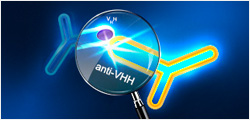| Species |
Human |
| Protein Construction |
CXCL11 (Phe22- Phe94)
Accession # O14625 |
|
| Purity |
> 97% as analyzed by SDS-PAGE
> 97% as analyzed by HPLC |
| Endotoxin Level |
< 1 EU/μg of protein by LAL method |
| Biological Activity |
The biological activity determined by a chemotaxis bioassay using human IL-2 activated human T-lymphocytes is in a concentration range of 0.1-10 ng/ml. |
| Expression System |
E. coli |
| Theoretical Molecular Weight |
8.3 kDa |
| Formulation |
Lyophilized from a 0.2 µm filtered solution in 20 mM PB, pH 7.4, 100 mM NaCl. |
| Reconstitution |
It is recommended that this vial be briefly centrifuged prior to opening to bring the contents to the bottom. Reconstitute the lyophilized powder in sterile distilled water or aqueous buffer containing 0.1 % BSA to a concentration of 0.1-1.0 mg/ml. |
| Storage & Stability |
Upon receiving, this product remains stable for up to 6 months at -20°C or -70°C. Upon reconstitution, the product should be stable for up to 1 week at 2-8°C or up to 3 months at -20°C. Avoid repeated freeze-thaw cycles. |
| Target Background |
CXCL11 also known as I-TAC is belonging to the CXC chemokine family and shares 36 % and 37 % amino acid sequence homology with IP-10 and MIG, respectively. It is highly expressed in peripheral blood leukocytes, pancreas and liver. Expression of CXCL11 is strongly induced by IFN-γ and IFN-β, and weakly induced by IFN-α. This chemokine elicits its effects by binding to the cell surface chemokine receptor CXCR3, which with a higher affinity than do the other chemokines for this receptor, CXCL9 and CXCL10. Similar to CXCL10, CXCL11 has been shown to be a chemoattractant for IL-2-activated T-lymphocytes, but not for isolated T-cells, neutrophils or monocytes. |
| Synonyms |
I-TAC; Beta-R1; H174; IP-9; Small-inducible Cytokine B11 |
For laboratory research use����� only. Direct human use, including taking orally and injection and clinical use are fo�������rbidden.

































